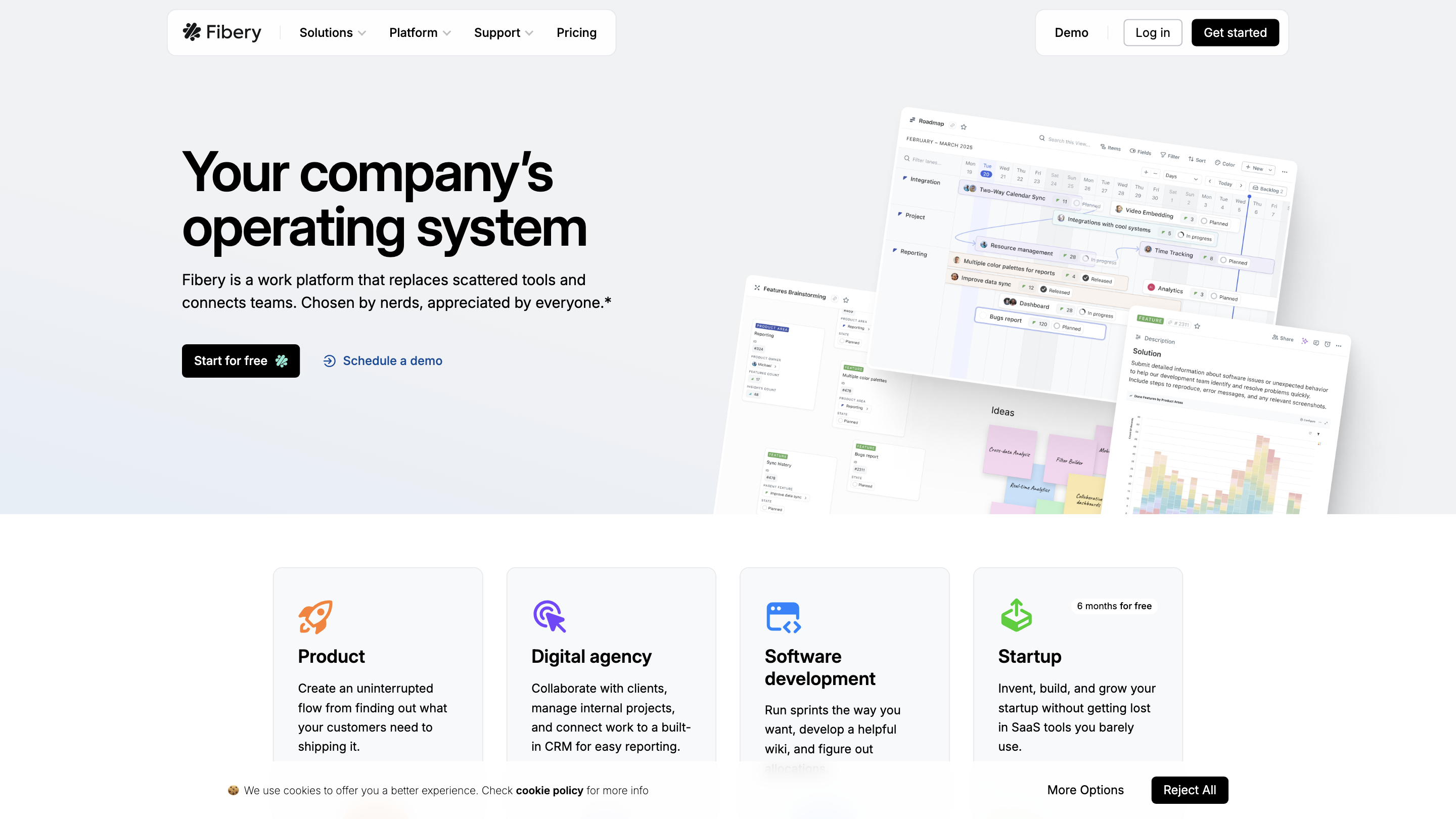Fibery
Open siteOffice & Productivity
Introduction
Fibery offers a customizable workspace solution with connected databases, reports, and AI capabilities.
Fibery Product Information
Fibery — Your company's operating system
Fibery is a work platform designed to replace scattered tools by connecting teams within a single, customizable workspace. It combines data, documents, projects, and workflows into one interconnected system, enabling you to capture, model, and automate how work gets done across product, engineering, marketing, and operations.
What Fibery does
- Offers a no-code/low-code environment to create custom workspaces, databases, views, automations, and integrations tailored to your processes.
- Replaces or connects multiple tools (PM, CRM, wiki, docs, planning boards, knowledge bases) with a single source of truth.
- Provides templates and blocks for common business functions (product management, retrospectives, software development, customer success, etc.).
- Includes a built-in AI (Fibery AI) to brainstorm, automate tasks, and surface relevant data.
- Supports flexible permissions, custom hierarchies, and cross-team collaboration.
How it works
- Create Your Workspace: Build the exact data models (databases) you need, with custom fields, relations, and views.
- Model Your Work: Use entities (records) to represent items like projects, tasks, customer records, or any other concept.
- Visualize & Plan: Use different views (tables, kanban, calendar, timeline) to plan and track work.
- Automate & Extend: Use no-code automations and formulas, or extend with code where needed. Integrations connect Fibery to other tools.
- Collaborate in One Place: All teams access shared data, ensure alignment, and reduce tool sprawl.
How to get started
- Start with a starter workspace or template relevant to your domain (Product, Software Development, Startup, Digital Agency).
- Define your core entities (e.g., Product, Feature, User Story, Issue, Customer, Project).
- Build relationships between entities to reflect your processes (e.g., a Feature belonging to a Roadmap, a Task belonging to a Sprint).
- Add views and dashboards to surface the information teams need.
- Implement automations to streamline repetitive tasks (status changes, notifications, data syncing).
Use cases
- Product Management: roadmaps, requirements, backlogs, OKRs, and release planning.
- Software Development: sprints, wiki, allocations, bug tracking, and changelogs.
- Digital Agencies: client projects, time tracking, invoices, and internal project management.
- Startups: rapid organization of ideas, experiments, and growth initiatives.
- Custom No-Code Spaces: tailor-made spaces for unique workflows.
Template library & integrations
Fibery provides a rich Template library to discover and customize templates for:
- OKR Tracking
- Product Management
- Retrospectives
- Custom No-Code Spaces
- GitLab Integration
- Project Management
- Finance
- Customer Feedback
Integrations connect Fibery with your existing tools to centralize data and automate cross-tool workflows.
Core Features
- No-code/low-code workspace customization: Build your ideal data model, views, and workflows.
- Unified data model: Capture and relate diverse data (projects, tasks, users, customers, docs) in one place.
- Flexible permissions and sharing: Granular access control and sharing of entities and hierarchies.
- Automations and formulas: Automate processes and compute values without heavy coding; extend with JavaScript for power users.
- Multiple views: Tabular, Kanban, Timeline, Calendar, and custom dashboards.
- Templates and templates gallery: Ready-to-use patterns for common business needs.
- Builder-friendly for cross-team collaboration: Break silos with interconnected spaces.
- Fibery AI: Brainstorm, automate tasks, and surface relevant data to speed decision-making.
- No-sign-up or external data hoarding requirements: Data stays in your Fibery workspace (subject to your plan and integrations).
- Flexible deployment: Works for product teams, software development, startups, and services.
Safety & privacy considerations
- Data stays within your workspace by design; configure permissions to control who can view or edit data. Use integrations judiciously to protect sensitive information.
What people say
- Fibery positions itself as a versatile, interconnected operating system for teams, aiming to replace fragmented tools with a single, customizable platform.
